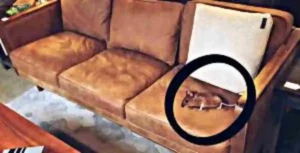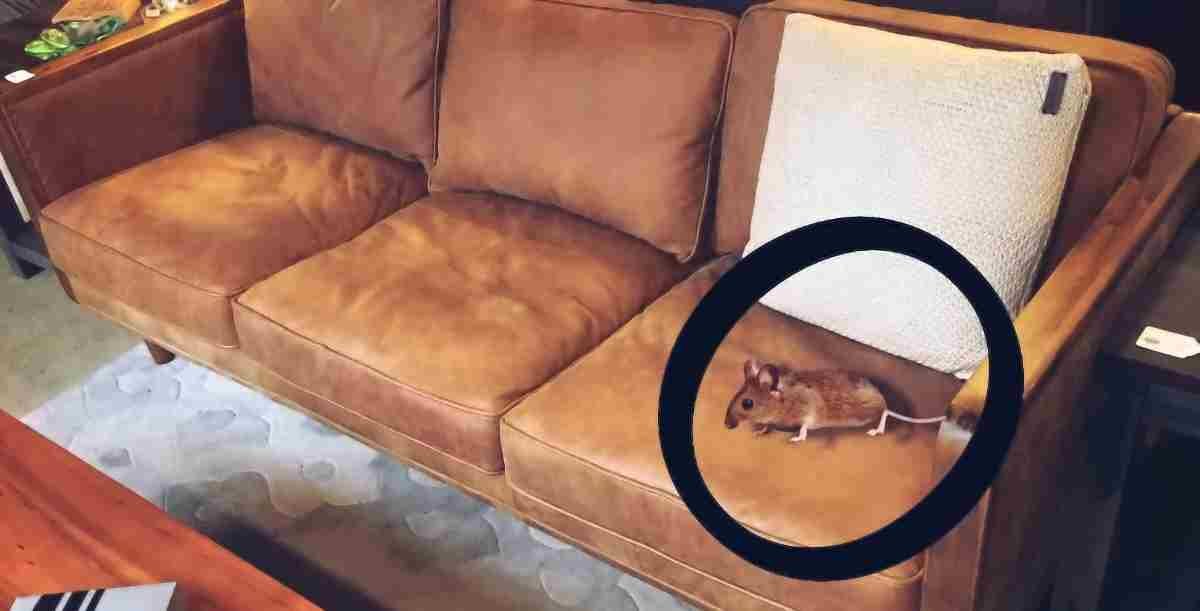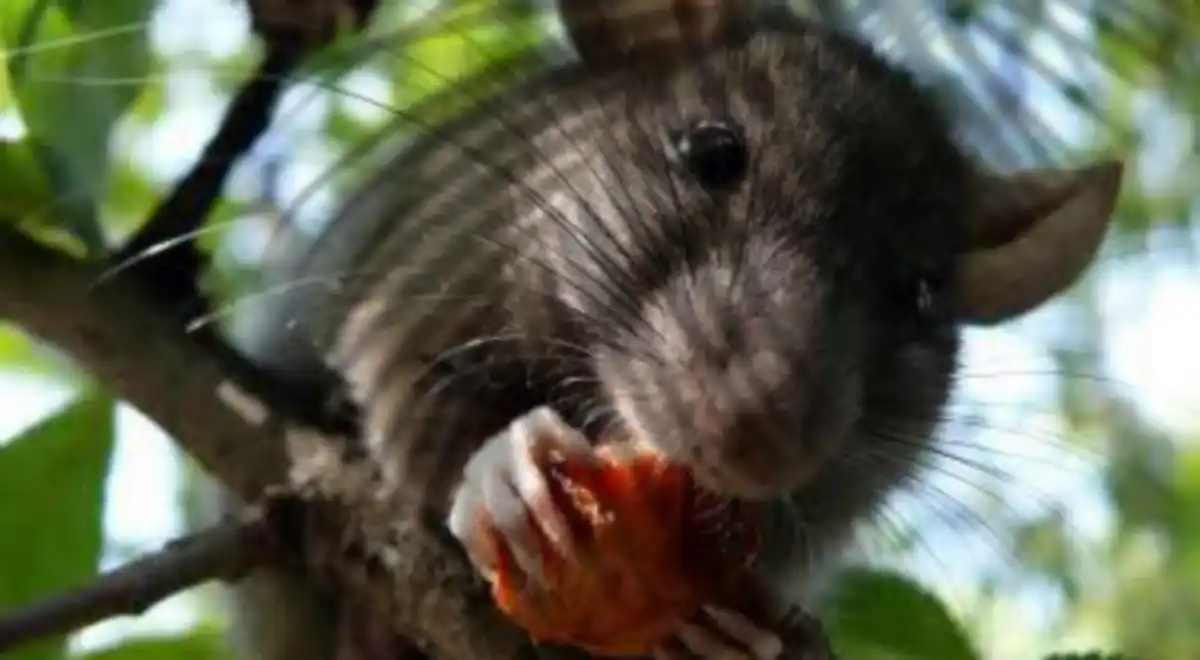It helps to know the signs of mouse in sofa if you suspect one in there. Usually, mice will gnaw a hole in your sofa, making you spend lots of money on repairs. In extreme cases, they can turn your sofa into their home.
Mice get a lot of comfort from hiding in sofas. They use the soft cloth in it and the stuffing to build a cozy nest. The foam and other soft materials completely mute the noises these pests make in there.

Can mice live in your sofa?
Mice can live in your sofa. Sofas make a great place for a mouse to hide and the comfort from it makes it a great nesting place. The soft materials in the sofa make the mice very relaxed, so much so that they won’t want to leave. The cloth and foam inside the sofa muffle any form of activity that takes place.
Do not put any poisonous substances in the sofa. Anything that kills mice and rats is capable of killing and making humans sick. Poisoning your sofa can cause health issues for you and your household, including guests. Especially those battling with a heart attack or stroke. Instead of bait poisoning, use traps for pest control.
To catch mice you suspect in your sofa, you will ideally need at least 6-8 snap traps near the sofa or their food and water sources. Set the trap properly under the sofa or the sink, fridge, stove, near a waste bin, and in cabinets.
You can set two traps close to each other so the mouse or mice won’t be able to escape. A mouse usually sources food in the kitchen, thus, if you trap them in the kitchen, your sofa will no longer suffer from their ferocious residence.
Signs of mouse in sofa
Having known that a mouse can nest in your sofa, what are the possible signs that you have an active mouse in there?
1. live or dead mice near the sofa
Mice feature large ears and small black eyes. They have fine fur that can be black, grey, or brown, depending on the species. Mice are typically 3-4 inches long and feature a smooth tail. The fully developed mice grow up to 6-7 inches long, including their tail, and weigh ½ to 1oz.
Mice don’t like to be seen for fear of predators, they mostly come out at night. It is still very possible to see them at noon. Also, mice can be bolder, and may sometimes not feel threatened while going in search of food at noon.
Oftentimes people complain about seeing things dashing under furniture or dead rodents which are a sign of a mouse in the sofa. They always crawl to hidden places when dying (especially if you poisoned the bait), and you will always see their bodies in the open. Moreover, if you smell a dead mouse next to or under your sofa, there may be others (could be babies) nesting in it. If you accidentally touch the dead mouse, make sure to thoroughly wash your hands with soap and water.
2. Visible sofa damage
Most of the time, sofa damage can indicate a mouse infestation. Since a mouse’s teeth are always growing, an adult mouse must regularly chew on wood and other carbon materials to wear them down. As explained in Karen Froberg-Fejko’s research Give a rat a bone: satisfying rodents’ need to gnaw, “rodents have open-rooted dentition, meaning that their teeth grow continuously throughout their lives”.
When mice invade your sofa, they gnaw the wooden parts, the material, and other parts, leaving holes in them. Mice may also chew the furniture material to get the fluffy part of it for building their nest.
3. Sudden holes
A mouse-gnawed hole around the sofa is usually small, about the size of a dime. While gnawed rat holes are usually large and about the size of a quarter, with rough torn edges.
4. Mouse droppings
Mice droppings in couch are a sure sign that there are mice in your home. The amount of droppings also indicates the level of the infestation in your home as a whole.
Note that mouse droppings are small pellets, less than ¼ inch, and are pointed on both ends while rat droppings are mostly large or ½ inch. Norway rat droppings, for example, are blunt at both ends, while roof rat droppings have pointed ends.
New droppings look shiny and putty-like in texture, and the old ones are hard and crumbly. Most of the time, older droppings around the sofa mean the mice have been in there for a while and an infestation is already in place. Fresh mice droppings in sofa suggest that an infestation may just be starting.
On the other hand, feces sizes indicate whether you have baby or adult mice in the sofa or couch.
5. Scratching noises
Generally, mice set up their homes in cavities, cracks in walls, ceilings, floors, and roof spaces. They come out majorly at night in search of food and are very quiet animals, so their noises are more of scratching sounds. This noise generates from their movement or activities such as when they are gnawing on your sofa. It could indicate that they are creating a new route to your valuables or building their nest.
6. Urine smell
Mice’s urine has a strong offensive smell, more like ammonia. Most times, the first sign of mice infestation is a harsh smell that lingers on the sofa. Opening your windows and doors and other activities such as cooking can conceal the urine odor. As the smell grows stronger, so does the infestation increase.
7. Allergies
Allergies can be triggered by the presence of mice, just as some people are allergic to cats or dogs. These are commonly triggered by mouse droppings. So, if you start to feel dizzy or ill, and there are no explanations, it could be the mouse evidence in the sofa you sit or lie on causing the allergic reaction.
8. Pet activities
There’s this belief that cats always catch mice. However, sometimes or some pets may not bother to chase the mice. Pets like cats and dogs are generally inquisitive, so if they concentrate their activities on your sofa, it’s a sign that there might be mice nesting there. Moreover, cats and dogs tend to have much better hearing abilities than compared to humans, so they are likely to detect mice before you do.
9. Visible nesting materials
Mice usually tear off materials like paper, strings, etc., to make their nests indoors. If you notice paper shreds or fabric pieces around your sofa, those are indications of mice presence.
How do I get a mouse out from under my couch?
Being able to identify the signs of a mouse is one thing—expelling them is another. Once you have spotted a mouse in your sofa or couch, questions on what to do about it come to mind. Mice have grown to live alongside humans. Even when you exterminate them, they develop strategies to get around your measures or just leave your home to return when it’s attractive again.
But for now, do the following to get the mice out of your sofa:
Mouse proofing is best
An effective way to get rid of mice is to mouse-proof. A professional pest exterminator will identify potential mice entry points, and then block them to keep them at bay.
This also means that the mice will not have access to the food and water they need to survive. Since your property is no longer attractive, they either move to another property or starve to death.
Repel with potent scents on your sofa
When you spray an unpleasant solution in the sofa or couch where the mice hide, it forces them out. Mice won’t stand the scent of garlic, onions, cayenne pepper, cloves, ammonia, and alcohol. According to popular opinion, the best substance to use is peppermint oil—it smells good without harming your pets.
Another repellent is the mothball. With ⅛ size holes, cut near the top of an old plastic milk bottle, fill halfway with water, and place 10–12 mothballs in the sofa to get a mouse out.
Also, you can tie up a handful of star anise, cinnamon sticks, and cloves in cheesecloth with a string and place them next to your couch and other nearby areas. Mice hate cloves and will exit the couch.
Not only do these solutions keep mice away, but they also smell nice and won’t cause harm to your pets.
Place traps and baits
The different traps in the market include snap traps, glue traps, etc. Snap traps are less pricey, easy to use, and can kill rodents instantly. Glue traps, however, are considered inhumane, although good options for controlling rodents you don’t want to snap their paws.
On the other hand, poisoned baits are a mess solution for eliminating mice. You must poison the bait and place them next to your couch, where mice nest. After a rodent eats the bait, it dies within 1-2 days. In some cases, mice can eat poison but won’t die. You may need new substances or wait for some days since the rodenticide may be a slow reacting type.
Just some baits under your sofa. If you intend baiting, think also that the mice can rot under your sofa. The disadvantage is that you will have to deal with a rotten smell and dead body.
Remove the sofa cushion at night (since mice get under couch cushions) and neatly place a newspaper on it to protect the furniture. Next, place the snap trap on the newspaper. You may not immediately get the results, but continue the process for some nights and replace the old peanut butter with fresh ones every night to improve the chance of capturing mice in the sofa.
Read also: bleach may remove remove urine in ceiling
Conclusion
If you have been experiencing mice infestation on your sofa for a long time, there may be an infestation and droppings in it or even baby mice. When getting rid of the droppings, nesting materials, and urine, make sure not to handle them with bare hands. Instead, apply disinfectant to the possibly contaminated area
Ultimately, it’s safer to dispose of the furniture. But if you must keep the sofa, take drastic measures to restore the sofa healthily. You want to contact local professionals to exterminate the mice if you have difficulty expelling them from your home.






